(Image credit: Marine Imaging Technologies, LLC/Woods Hole Oceanographic Institution)
From BBC by By Isabelle Gerretsen
Could our understanding of the deep ocean help unlock the mysteries of outer space? Nasa's space mission is leading us to unexplored depths of our own planet.
Our oceans cover more than 70% of the Earth's surface, but over 80% of them remain unexplored.
In fact, it is often claimed that we know more about the surface of Mars and the Moon than about the ocean floor on our own planet.
Nasa is on a mission to change that.
The US space agency is exploring the deep ocean to search for clues of what oceans on other planets could look like, and push the limits of science and technology in one of the most extreme environments on our planet.
It is a mission filled with wonder, danger and a not-insignificant risk of implosion.
The hope is that the underwater discoveries they make will help to unlock some of the mysteries in outer space while also test some of the equipment and experiments needed for missions elsewhere in the Solar System.
Earth's ocean depths are surprisingly similar to some of the conditions Nasa expects to find on other worlds in our Solar System.
They could even provide clues about where scientists should be searching for alien life.
The deepest parts of Earth's oceans are known as the hadal zone.
Named after Hades, the Greek god of the underworld, it is a forbidding place worthy of its name.
Consisting of deep trenches and troughs, it extends 11km (6.8 miles) below the surface of the world's oceans.
Cumulatively they account for an area of seabed equivalent to the size of Australia.
Yet few vehicles can survive plunging into this dark abyss.
It is here that Nasa scientists, in partnership with the Woods Hole Oceanographic Institute (WHOI) in Massachusetts, are attempting to explore and probe the limits of life on Earth.
Even the language the scientists use for their missions to this region shares terms with space exploration – in recent years marine biologists have sent multiple "landers" equipped with sensors and cameras to "crash-land" on the floor of the hadal zone, where they take measurements.
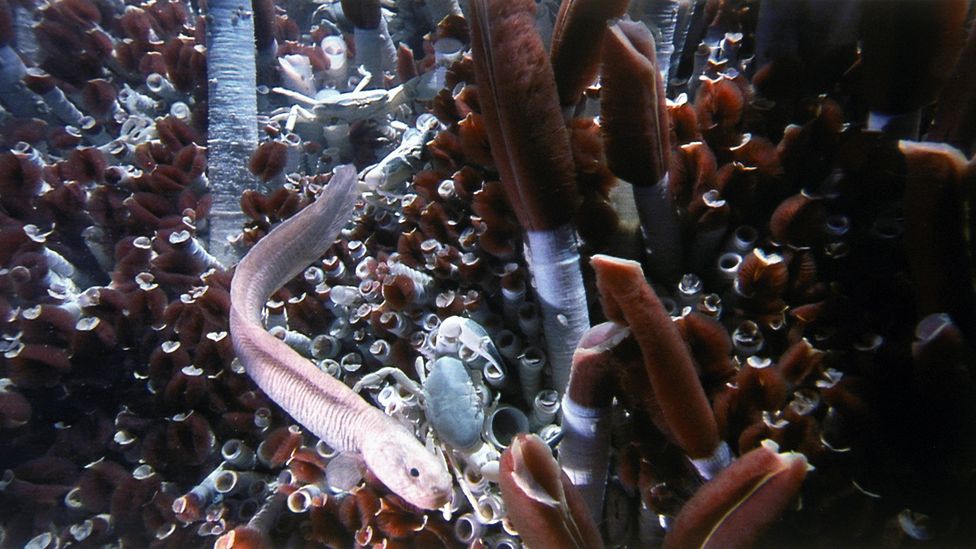
Once thought to be devoid of life, hydrothermal vents in the deep ocean have been found to teem with creatures (Credit: Science Photo Library)
But
engineers from Nasa's Jet Propulsion Laboratory in Southern California
are building a new autonomous underwater vehicle called Orpheus, after
the ancient Greek hero who travelled to the underworld and back, to map
the more inaccessible depths.
Using similar visual navigation technology
to Nasa's Perseverance Mars Rover,
Orpheus uses highly sensitive cameras to identify rock formations,
shells and other features on the ocean floor to build up
three-dimensional maps dotted with landmarks (or perhaps seabedmarks).
This allows the robot to find its way and recognise places it has
already been, but should also help it shed new light on the biodiversity
of this harsh environment.
"Orpheus is a gateway vehicle," says Tim
Shank, a deep sea biologist who is leading WHOI's hadal exploration programme.
"If it works, there is no place in the ocean where you can't go."
It is not the first time that Shank has tried to reach the dark depths of the hadal zone.
In 2014, Orpheus' predecessor Nereus was sent down to the Kermadec Trench, which lies north-east of New Zealand.
The underwater vehicle imploded some 10km (6.2 miles) down, most likely due to the immense pressure.
"After 12 hours, we saw it coming up in small pieces," says Shank,
adding that the loss of Nereus made them rethink how they explore the
deep sea.
About the size of a quad bike and weighing around 550 pounds
(250kg), Orpheus is designed to be much lighter, smaller and cheaper
than previous underwater vehicles.
This should make it nimbler too,
allowing it to get into trenches and vents in the sea floor that have
never been explored before.
Europa on Earth
For a long time, marine biologists thought that life in the hadal zone was impossible, but as deep sea submersibles began venturing into the region in the first half of the 20th Century, it became apparent life could survive there.But it was still believed that all living organisms were sustained by a food chain ultimately fueled by photosynthesis.
Plants, algae and some marine bacteria in surface waters convert the Sun's energy into sugars which they store in their organic matter.
This is then eaten by herbivores, which in turn are eaten by carnivorous animals.
Scientists were convinced that organisms on the ocean floor survived off dead organic matter – the carcasses of animals, faeces and the steady fall of other organic detritus or "marine snow" drifting down from above.
But it was thought there was not enough food to sustain anything much in the way of sea creatures and the deepest areas were believed to still be too dark and cold for life.
These are animals that don't require direct sunlight… they live off chemicals coming out of the sea floor – Tim Shank
But this perception of the deep ocean changed in 1977, when a US research team dropped a remotely operated vehicle 8,000ft (2,440m) into the Pacific Ocean.
The vehicle was dispatched to take images of hydrothermal vents, where heat from volcanic activity seeped from the ocean floor.
To their amazement, the scientists discovered vibrant ecosystems around the vents, teeming with marine organisms, such as translucent snailfish and amphipods, tiny flea-like crustaceans, that had never been seen before.
"With this discovery, we [came across] a whole new way of living on Earth," says Shank.
"These are animals that don't require direct sunlight... they live off chemicals coming out of the sea floor."
The scientists were perplexed: how could species in the hadal zone survive such crushing pressure?
"The pressure is 15,000 pounds per square inch," says Shank.
"It's so intense that the individual cells of an animal would be squeezed out."
Since that first sighting in 1977, scientists have discovered that organisms living at such depths have adapted on a cellular level to survive down there, says Shank.
Creatures in the hadal zone, such as giant amphipod crustaceans and the snailfish,have enzymes called piezolytes (from the Greek "piezin" for pressure), which stop their cellular membranes and proteins from being crushed under extremely high pressure.
The piezolytes counteract the pressure by increasing the space that proteins take up inside the organism's cells to counteract the weight of the water around it.
"It's like putting the stakes up in a tent," says Shank.
The vehicle was dispatched to take images of hydrothermal vents, where heat from volcanic activity seeped from the ocean floor.
To their amazement, the scientists discovered vibrant ecosystems around the vents, teeming with marine organisms, such as translucent snailfish and amphipods, tiny flea-like crustaceans, that had never been seen before.
"With this discovery, we [came across] a whole new way of living on Earth," says Shank.
"These are animals that don't require direct sunlight... they live off chemicals coming out of the sea floor."
The scientists were perplexed: how could species in the hadal zone survive such crushing pressure?
"The pressure is 15,000 pounds per square inch," says Shank.
"It's so intense that the individual cells of an animal would be squeezed out."
Since that first sighting in 1977, scientists have discovered that organisms living at such depths have adapted on a cellular level to survive down there, says Shank.
Creatures in the hadal zone, such as giant amphipod crustaceans and the snailfish,have enzymes called piezolytes (from the Greek "piezin" for pressure), which stop their cellular membranes and proteins from being crushed under extremely high pressure.
The piezolytes counteract the pressure by increasing the space that proteins take up inside the organism's cells to counteract the weight of the water around it.
"It's like putting the stakes up in a tent," says Shank.
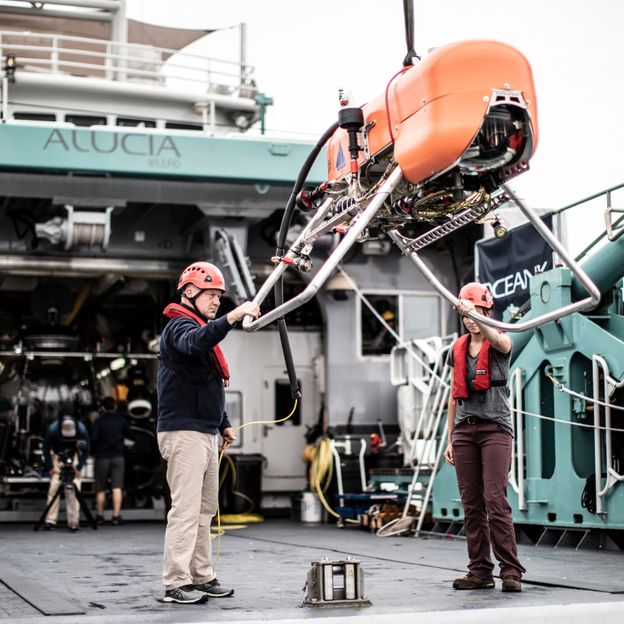
Orpheus is constructed using some of the foam left over from James Cameron's Deepsea Challenger (Credit: Woods Hole Oceanographic Institution)
Discovering organisms that can not only survive, but thrive in such an oppressive environment, raises important questions for biologists looking beyond the realms of our own planet – might it also be found on other ocean worlds.
Below the icy surface of Jupiter's moon Europa lies a salt-water ocean that is thought to be between 40 to 100 miles deep (60-150km) and contains twice as much water as all of Earth's oceans combined.
Sunlight doesn't penetrate below Europa's thick ice sheet, which is crisscrossed by cracks and fractures.
Beneath the icy crust, the pressure is comparable to the hadal zone.
"Here we have Europa on Earth," says Shank.
"I don't see how we could do exploration on Europa, until we did it on Earth."
A robot capable of exploring the Earth's hadal zone could do the same on a frozen moon 628.3 million km (390.4 million miles) away.
"The ocean floor is a great testbed for us to develop the technology that we need in order to have a successful mission to one of these ocean worlds," says Russell Smith, an engineer from Nasa's Jet Propulsion Laboratory, who is part of the team building Orpheus.
A robot operating in outer space or the deep ocean, however, must be completely autonomous.
"The robot has to be able to make decisions," says Smith, noting that the aim is for Orpheus to be able to detect and classify environmental DNA and chemicals in the water, as well as bring back samples from the ocean floor.
Building a robot for the hadal zone is incredibly challenging, he says.
Orpheus has to withstand intense pressure and temperature extremes – the water in the hadal zone is just above freezing, but in the hydrothermal vents temperatures can reach 370C (698F).
"Developing a vehicle that is going to survive is really hard," says Smith.
"You need really thick walls to prevent the electronics from getting crushed or wet." Orpheus is partly constructed from syntactic foam, a buoyant material composed of microscopic glass spheres set in epoxy resin.
The foam used in Orpheus comes from leftover material produced for film director James Cameron's Deepsea Challenger, which descended to the bottom of the Mariana Trench, in the western Pacific, in 2012.
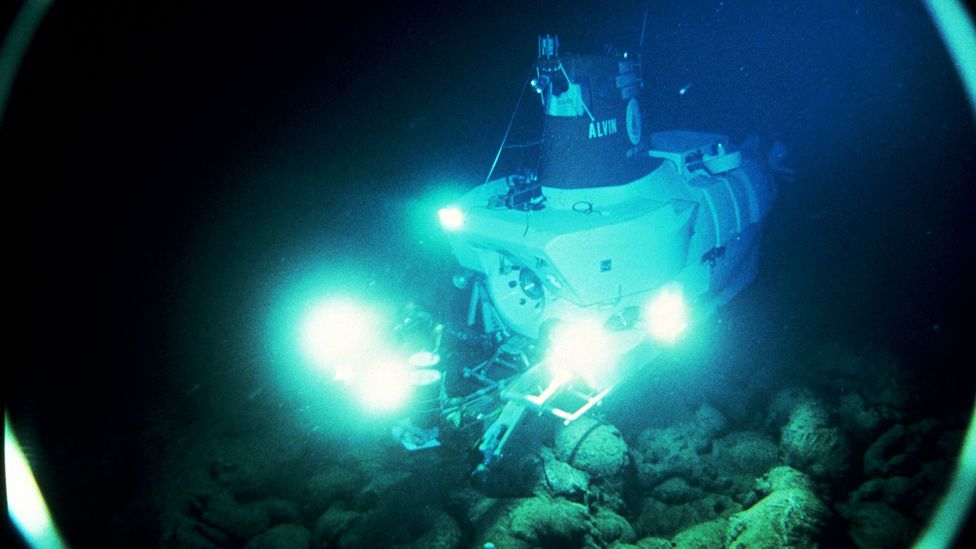
Alvin was the first remotely operated vehicle to visit hydrothermal events when it dived to the deep sea floor in 1977 (Credit: Ralph White/Getty Images)
As it is pitch black in the deep ocean, Orpheus is equipped with a huge flashlight.
If the light stays on the entire time, it will quickly drain the robot's battery, leaving it stranded at the crushing depths.
To conserve power, Orpheus will switch to a low-power mode when it isn't taking images or samples, says Smith.
Mission to the Moon
In 2017, Nasa launched the Systematic Underwater Biogeochemical Science and Exploration Analog, also known as Subsea, to bring together the fields of space and ocean exploration.
To date, they have carried out two missions with remotely operated vehicles to hydrothermal vents in the Pacific Ocean.
The volcanic activity around the Lō`ihi seamount, around 30km (19 miles) off the coast of Hawaii, and Gorda Ridge, 120km (75 miles) off the US coast where California and Oregon meet, is thought to be similar to what may be found in the ocean worlds on Europa and Saturn's moon Enceladus.
In 2023, Nasa will send a robotic rover to look for water-ice at our Moon's south pole
"The whole project was predicated on finding areas in our deep ocean that had a really good analogous nature to what is predicted to be active in places like Enceladus," says Darlene Lim, a Nasa geobiologist who is leading the Subsea programme and preparing astronauts for exploration of the Moon and deep space.
Scientists used the two Subsea missions to gain a better understanding of the geology and chemistry of these vents and the life found around them.
"These vents are very innocuous," says Lim.
"You have to look very closely for a temperature change in the water coming up through the ground and interacting with very cold seawater.
Even that act alone is very valuable for how we might anticipate having to do exploration on some of these ocean worlds in our solar system."
While sending robots to Europa and Enceladus may still be decades away, Nasa scientists are already applying what they have learned from deep ocean exploration to space missions.
In 2023, Nasa will send a robotic rover to look for water-ice at our Moon's south pole.
The mission known as the Volatiles Investigating Polar Exploration Rover, or Viper, will study ice near the lunar crater Nobile in the hope it could be mined as a resource for rocket fuel or drinking water.
While not operating underwater, a rover roaming around on the Moon will face many of the same technical challenges.
"We're taking all the learnings from Subsea and applying it to Viper," says Lim, who is also the deputy lead project scientist on Viper.
The aim of the Subsea programme was to ensure that scientists met their research goals in extremely challenging conditions, both from a communications and technology perspective.
From an operations perspective, ocean and space exploration also have a lot in common.
In both fields, robots are sent to explore treacherous environments which humans cannot reach, supported by remote teams of scientists.
But it could also help prepare astronauts for controlling robotic equipment from a lunar base in the future too.
Fewer than 10 scientists went out to sea with the Subsea mission and they worked with a larger group of colleagues on shore.
For the Viper mission, a team will operate the rover on Earth in near real-time and will have to analyse data and make decisions very rapidly.
Efficient communication is critical during these missions, says Zara Mirmalek, a social scientist with Nasa who helps scientists prepare for exploration in extreme environments, and has worked on both the Subsea and Viper programmes.
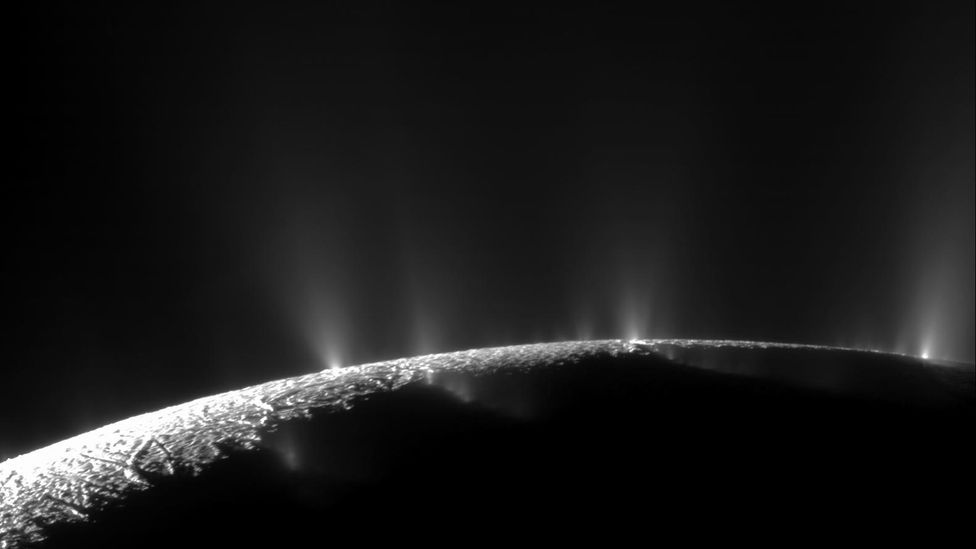
Plumes of water vapour burst from the icy surface of Saturn's sixth largest moon Enceladus – signs of the liquid ocean lurk below (Credit: Nasa/JPL/Space Science Institute)
For deep sea exploration, scientists have to change decisions all the time, depending on the ocean conditions, weather and salinity.
"You know that you are going to have less time than you planned for," says Mirmalek.
"It's a lot harder to work in the deep ocean because the conditions are so challenging to the technology."
On space missions, communication is extremely limited, says Mirmalek.
To prepare for outer space conditions, Mirmalek restricted the Subsea scientists to communicating with each other just once a day.
"There were no failures – they met all their research goals," she says.
"Everything we learned by working together with the oceanographic community has been completely invaluable, really priceless, in helping us have confidence in the process that we're using to design our science operations for Viper," says Lim.
But much like missions off our planet, those to the bottom of the oceans are also allowing humanity to look at the Earth in new ways.
While Nasa says its oceanographic explorations have yielded "thousands" of scientific discoveries, they are also providing information that could be vital if we hope to continue living on a world with healthy oceans.
We need to understand our oceanic environments if we are to save them, says Laura Lorenzoni, ocean biology and biogeochemistry program scientist with the science mission directorate at Nasa.
"This is critical for life on Earth, and the sustained measurements Nasa has done, and continues to do, are fundamental for ensuring a sustainable use of our ocean resources," she says.
It means that each step towards the exploration of other worlds, we learn a little bit more about some of the most unexplored parts of our own blue planet too.
Links :
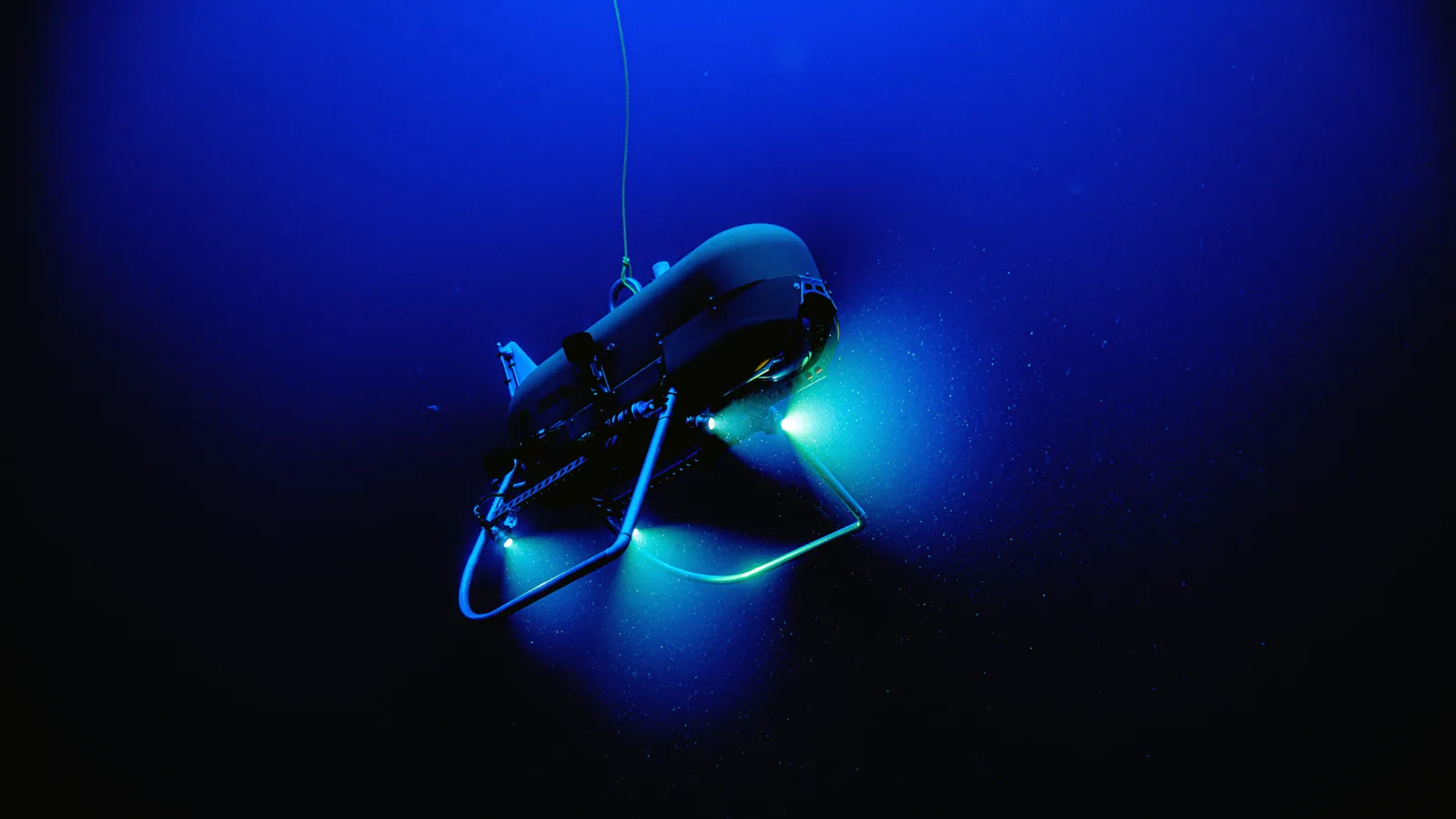
No comments:
Post a Comment